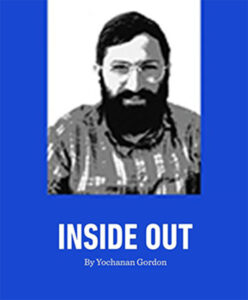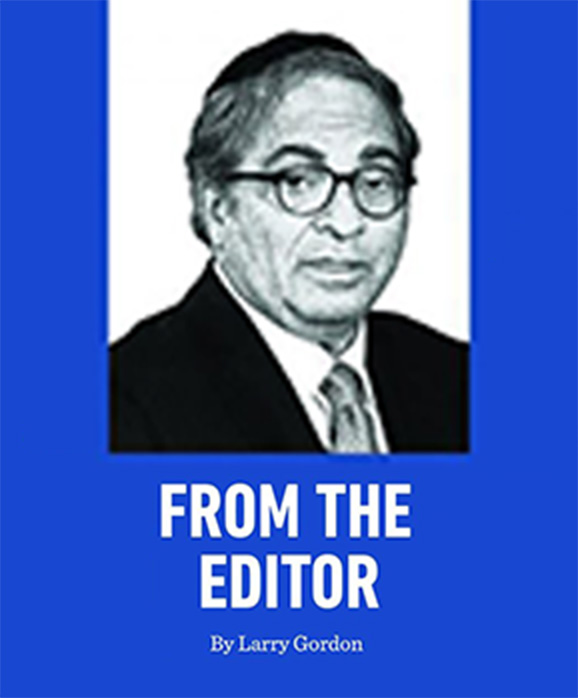Inside Out
By Yochanan Gordon
I realize that the title and header are the same: this was done by design. Allow me to explain. After two months of quiet bliss with five of our six kids away at sleepaway camp, four of them returned home with a mountain of laundry that demanded our immediate attention. All quiet flew out the window.
I remember the first time my oldest kid went to sleepaway camp. When the luggage delivery service rang our doorbell to drop off his luggage, the man stood there holding two empty bags with a sheepish look on his face, explaining that most of the stuff we sent with him had been left in camp.
It’s funny, because after arriving home this evening, there were baskets of laundry and hanging racks erected all over the house. Overwhelmed by the amount of laundry strewn everywhere, I told the kids that I would have preferred they left all the stuff back in camp.
Actually, I was thinking that it would have been nice for the camp to send the kids home in shifts. It’s a little overwhelming to go from an empty house, where nights are mostly quiet, to having to contend with mountains of laundry and endless rounds of washing and drying and the resulting noise and massive piles of folded laundry that entails.
That’s when the idea for this article was born. As I mentioned last week, the objective of this column which began over five years ago, was to explore Torah, observations, and life from the inside through the lens of penimiyus HaTorah or Chassidus.
Life is challenging on a number of levels. Some people struggle financially, while others struggle with infertility, and still others struggle with the challenges of raising children, health problems, etc. The point is that anyone who is capable of complaining about piles of laundry at the end of summer is doing pretty good. Yet, as we know, laundry is a source of stress.
Our sages say, “If a scoundrel hurts you, drag him to the beis midrash.” If this scoundrel (the yetzer hara) bothers you, pull him into the beis midrash and deal with him there. In the realm of penimiyus, our rabbis are saying that we have the ability to interface with our challenges in life either physically or spiritually.
The Gemara interprets the pesukim regarding Egyptian slavery as a form of toil and labor the Jews could have discharged via the realm of Torah study instead of manual labor.
“And they embittered their lives with difficult work.” The Hebrew term for difficult work is “avodah kashah.” The Gemara reinterprets the word “kashah” with the Aramaic “da kusi,” which is a reference to Talmudic questioning.
The mortar, “chomer” is a reference to the Aramaic “kal v’chomer,” a fortiori.
And with bricks “u’b’levanim” is a reference to clarifying the halachah: “livon halkata.”
And the term, “b’chol avodah b’sadeh” is a reference to “baraita,” which is Aramaic for outside.
The Gemara is teaching us that the physical labor the Jews endured in Egypt and during their long exile can be fulfilled in the form of Torah study.
This is how the Chassidic masters interpret: “If the scoundrel hurts you, drag him to the beis hamidrash.” Whatever challenges and obstacles we are facing can be dragged into the beis midrash and dealt with there, rather than in the mundane physical world.
I’ll admit I find it challenging to apply this dictum to the piles of laundry that have invaded my house after two months of quiet bliss. It’s hard to drag these obstacles into the beis midrash when they’re crying out for laundry detergent and fabric softener.
In the absence of being able to think from the inside-out, we are left feeling turned inside-out and slightly disoriented.
There was once a poor Jewish tailor in a small village who was constantly worried. He fretted about having enough work, putting food on the table, and fixing the mounting piles of torn clothes the villagers left at his doorstep. One day he poured his heart out to his Rebbe:
“Rebbe, every day I sit surrounded by endless piles of clothing. I patch one hole and two more garments show up with tears. It feels like the galus itself: endless labor, and no matter how hard I work, the pile only grows. I’m drowning in fabric.”
The Rebbe smiled gently and said: “Zalman, you are looking at the piles, not the stitches. Don’t see it as endless toil, see it as a sugya. Every tear is a kushiyah and every patch is a teirutz. Each garment you mend is a page of Gemara. The pile doesn’t crush you when you realize you are not patching clothes; you are weaving Torah into the world.”
The tailor went home, and though the piles never shrank, he was no longer crushed by his toil. He worked with song, for he realized that his little wooden table had become a beis midrash.
Chazal tell us that Chanoch was a shoemaker who would affect divine unifications with every stitch that he sewed. We need to be mindful that our actions in this world create rectifications in the higher worlds. It is this mindset that will pull us through this difficult period between camp and school, and in the larger picture, between our present galus and the ultimate geulah. n
The author can be reached at [email protected].










